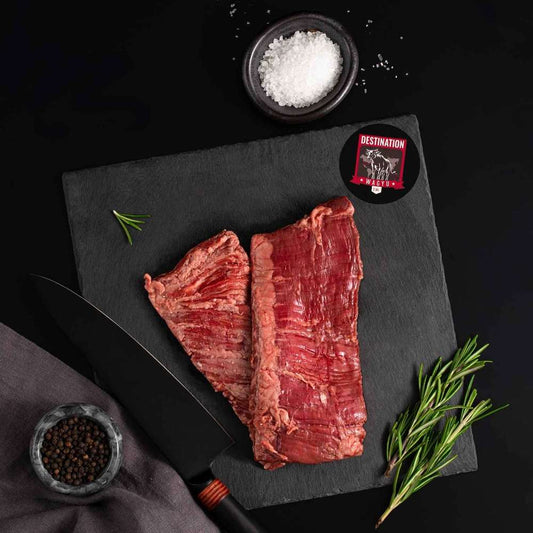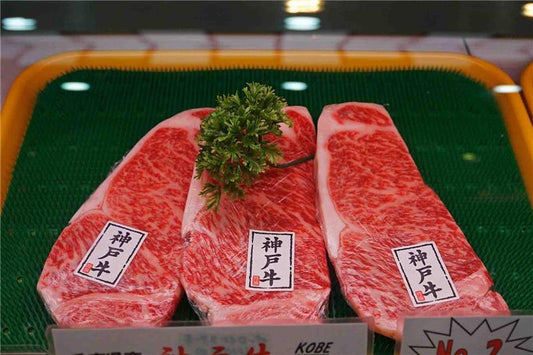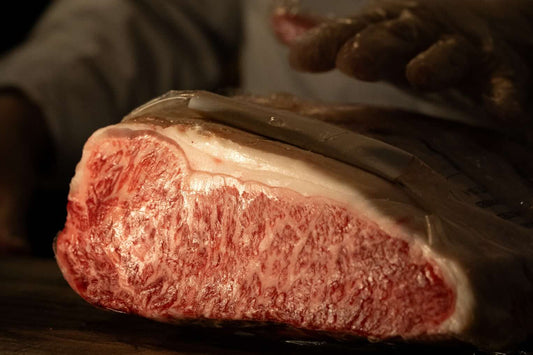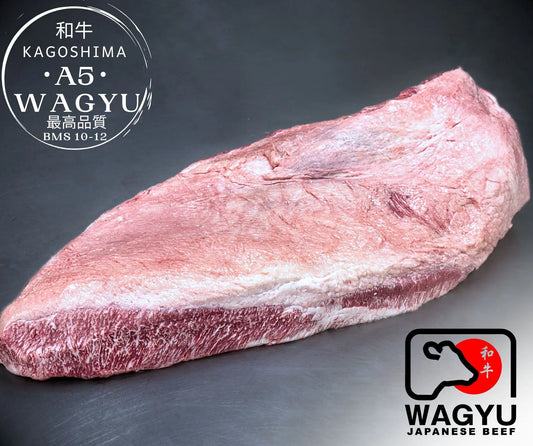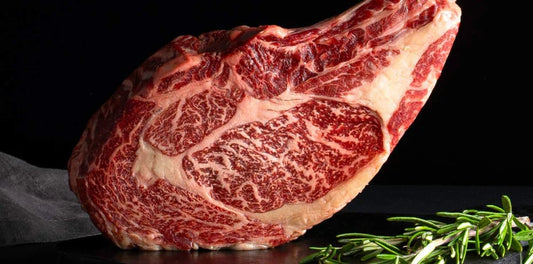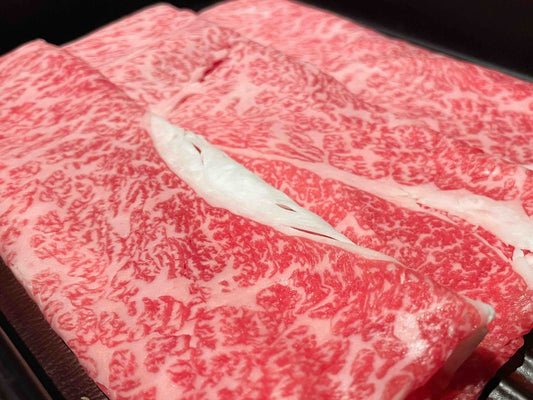Marbling is the most defining characteristic of Wagyu beef, setting it apart from all other beef breeds in the world. For those of us deeply involved in the industry—whether as producers, butchers, distributors, or chefs—understanding marbling is not optional. It directly impacts grading, market value, and culinary performance, and most importantly, it determines the eating experience of the final product.
Unlike conventional beef, where marbling is simply a contributing factor to quality, Wagyu’s value is entirely dependent on the extent, distribution, and quality of its marbling. The intricate network of intramuscular fat (IMF) found in Wagyu not only gives the meat its signature buttery texture and umami-rich flavor but also influences how the beef should be prepared, stored, and served.
In this article, I will take you through an expert-level breakdown of Wagyu marbling. We'll dive deep into the science behind it, explore the different global grading systems, analyze how marbling affects taste and texture, and discuss how producers can optimize marbling without sacrificing meat integrity. This is not an introductory guide; this is a comprehensive technical deep dive for professionals who want to master the nuances of Wagyu beef marbling.
The Science Behind Wagyu Marbling: Genetics, Physiology, and Development
Understanding Intramuscular Fat (IMF) and Its Role in Wagyu
Marbling, scientifically known as intramuscular fat (IMF), is the fat that is interspersed between muscle fibers rather than stored around the muscle (subcutaneous fat) or between muscle groups (intermuscular fat). This distinction is critical because IMF behaves differently when cooked, imparting unique mouthfeel properties and enhancing flavor diffusion.
Unlike intermuscular fat, which is often trimmed off, IMF is a structural component of the meat itself, meaning it melts during cooking, coating the muscle fibers with rendered fat. This results in a smoother, more velvety texture, and elevated umami due to the presence of free amino acids.
Wagyu marbling is extraordinary because of how finely and evenly dispersed this fat is. In most beef breeds, marbling appears in random patches, but in Wagyu, it creates a delicate, lace-like pattern that distributes flavor more uniformly. This is due to both genetics and highly controlled feeding regimens, which we will discuss in depth.
The Genetic Superiority of Wagyu for Marbling
Wagyu cattle are genetically predisposed to developing higher levels of IMF than any other breed. This is due to specific genetic markers that influence:
-
Fat Cell Differentiation: Wagyu have a genetic predisposition to store energy as intramuscular fat rather than subcutaneous or intermuscular fat. This is unlike most breeds, which deposit fat externally first.
-
Fat Composition: Wagyu fat is richer in monounsaturated fatty acids (MUFA), particularly oleic acid, which has a lower melting point than the saturated fats found in conventional beef. This contributes to the soft, melt-in-your-mouth texture.
-
Metabolic Efficiency: Wagyu cattle convert feed energy more efficiently into IMF deposition. This is why Wagyu requires longer feeding cycles (28-36 months) compared to conventional beef cattle (18-24 months).
A key genetic factor is the SCD (stearoyl-CoA desaturase) gene, which controls fatty acid saturation levels. Wagyu cattle with the AA genotype produce softer, higher-quality fat. Another critical genetic factor is FASN (fatty acid synthase), which regulates the amount of IMF deposited in muscle tissue.
Because of these unique genetic traits, fullblood Wagyu consistently outperform crossbred or conventional cattle in marbling potential. However, genetics alone do not guarantee high-quality marbling—it must be carefully optimized through feeding and environmental management.
How Marbling Develops in Wagyu: Growth Stages & Feeding Strategies
Marbling does not develop evenly throughout a Wagyu’s life. Understanding the timeline of fat deposition allows producers to strategically adjust feeding regimens to maximize IMF accumulation while avoiding excessive external fat buildup.
1. Early Growth Phase (0-6 Months): Foundation for Marbling
At birth, Wagyu calves have minimal IMF, as fat deposition has not yet begun. During this phase, the focus is on immune system development and gut microbiome establishment. Proper nutrition in these early months is critical—calves need high-quality milk and fiber-rich starter feeds to support skeletal and muscular development without premature fat accumulation.
2. Growth Phase (6-12 Months): Preparing for IMF Development
At this stage, muscle tissue is still developing, and excessive energy intake can lead to undesirable intermuscular and subcutaneous fat rather than IMF. Wagyu are typically fed high-fiber diets with controlled starch levels to ensure slow, steady growth without excessive fat deposition.
3. Fattening Phase (12-30+ Months): Maximizing Marbling Potential
This is the most critical stage for marbling development. The focus shifts from muscle growth to IMF accumulation, requiring a high-energy, grain-heavy diet. Wagyu are often fed a customized blend of corn, barley, wheat bran, soybean meal, and rice bran.
-
Energy-dense feeds encourage lipogenesis (fat deposition)
-
Extended feeding periods (up to 1,000 days) ensure deeper, finer marbling
-
Excessive feeding too early can lead to excessive external fat rather than IMF
This long-feeding strategy is why Wagyu achieves unparalleled levels of marbling compared to conventional beef.
Understanding Wagyu Grading: How Marbling is Measured & Evaluated
Japanese Meat Grading Association (JMGA) System
Japan's JMGA grading system is the most precise in the world. It assesses both Yield Grade (A, B, C) and Quality Grade (1-5) based on:
-
Beef Marbling Standard (BMS): 3-12 scale
-
Meat Color & Brightness: 1-7 scale
-
Fat Color, Luster, and Quality: 1-7 scale
-
Firmness & Texture: 1-5 scale
BMS 12 represents the absolute highest possible marbling score, typically found in elite, high-percentage Tajima bloodline Wagyu.
Why Other Systems (USDA, AUS-MEAT) Fail to Capture Wagyu Quality
-
USDA Prime only reaches the equivalent of BMS 5-6
-
Australian Wagyu marbling scores range from 1-9+, but lack fat composition analysis
-
Korean and European grading systems do not assess IMF with enough precision
Because of this, exporting and marketing Wagyu requires an understanding of how grading systems align globally.
How Wagyu Marbling Impacts Sensory & Culinary Experience
The Role of Marbling in Wagyu’s Texture and Mouthfeel
When discussing Wagyu, we often hear the phrase “melt-in-your-mouth”, but this isn’t just marketing hyperbole—it’s a scientifically supported phenomenon. The structure, composition, and distribution of intramuscular fat (IMF) in Wagyu fundamentally alter how the beef feels when eaten. Unlike conventional beef, where marbling tends to be more patchy and coarse, Wagyu marbling is finely woven into the muscle fibers, allowing for an even, luxurious mouthfeel.
One of the defining characteristics of Wagyu is its lower fat melting point. The fat in Wagyu contains higher concentrations of monounsaturated fats, particularly oleic acid, which has a melting point of around 25-30°C (77-86°F)—significantly lower than that of saturated fats, which typically require temperatures above 40°C (104°F) to liquefy. This means that as soon as the beef enters the mouth, the marbling begins to dissolve, coating the palate with a rich, velvety texture.
Moreover, the ratio of fat to muscle fiber plays a crucial role in how soft Wagyu feels when chewed. Unlike conventional beef, where excessive connective tissue can lead to chewiness, Wagyu’s marbling breaks apart muscle fibers, making each bite buttery and yielding. This is particularly evident in high-marbled cuts like A5 ribeye or striploin, where the density of fat ensures that even the slightest pressure from the tongue can break it down.
Flavor Chemistry: Why Wagyu Tastes Different
Marbling doesn’t just impact texture—it is also the primary driver of Wagyu’s signature flavor profile. The richness, depth, and umami-forward taste of Wagyu stem from a combination of fatty acid composition, amino acid presence, and cooking reactions.
1. Fatty Acid Profile and Its Effect on Flavor
The fat in Wagyu is chemically distinct from conventional beef. It contains high levels of monounsaturated fats (MUFA), particularly oleic acid (C18:1), which is known to enhance the perception of sweetness and umami. In contrast, conventional beef contains more saturated fatty acids (SFA), such as stearic acid (C18:0) and palmitic acid (C16:0), which contribute to a heavier, more cloying mouthfeel.
Oleic acid’s role in Wagyu is crucial because it is associated with:
-
A smoother, less greasy fat profile
-
A heightened ability to carry and distribute umami compounds
-
A lower melting point, resulting in an immediate, palate-coating effect
Furthermore, Wagyu’s high polyunsaturated fat (PUFA) content enhances flavor depth, as these fats act as precursors to aromatic compounds that develop during cooking.
2. Amino Acid Profiles and Umami Development
In addition to fat composition, Wagyu also contains higher levels of free amino acids, such as glutamate, inosinate, and guanylate, which are responsible for umami—the savory, mouthwatering taste that enhances meat flavors. These amino acids interact with the fat to create a more complex and lingering taste experience, particularly when the beef is lightly cooked.
Japanese Wagyu, especially high-grade A5 cuts, exhibit a higher concentration of glutamic acid, which pairs synergistically with the fat’s oleic acid content, leading to a sweeter, more umami-intense profile than conventional beef.
3. The Maillard Reaction and Marbling’s Role in Searing
When Wagyu is cooked, the Maillard reaction plays a crucial role in flavor development. This reaction, which occurs between amino acids and reducing sugars at high temperatures, creates the complex, caramelized crust on the meat’s surface.
However, because Wagyu contains more intramuscular fat, the way it undergoes the Maillard reaction is different from leaner beef. The rendered fat:
-
Accelerates browning, leading to a more pronounced crust formation
-
Enhances the formation of aromatic compounds, making the seared portion of the meat more fragrant
-
Prevents excessive moisture loss, ensuring the interior remains juicy even at high temperatures
This is why searing Wagyu properly—with a focus on gentle, controlled heat rather than aggressive charring—is key to maximizing flavor.
Cooking Techniques to Optimize Wagyu Marbling Expression
Given the high fat content and delicate structure of Wagyu, traditional Western steak cooking methods do not always yield the best results. A prime example is that high-heat grilling, which works well for leaner beef, can render out too much fat in Wagyu, leading to excessive grease loss and a diminished eating experience.
The best cooking methods for Wagyu preserve its marbling while allowing the fat to integrate seamlessly into the meat. Here are the most effective techniques:
1. Yakiniku-Style Grilling
-
Uses quick, high-heat cooking on a Japanese-style grill
-
Ideal for thin slices (1/8 to 1/4 inch), preventing excessive fat loss
-
Emphasizes fat caramelization without overcooking the interior
2. Sous Vide Cooking for Thick Cuts
-
Maintains precise temperature control, ensuring fat does not render prematurely
-
Ideal for highly marbled Wagyu steaks, as it keeps the fat within the meat
-
Best followed by a quick, high-heat sear on a cast-iron pan
3. Teppanyaki Cooking
-
Uses a flat-top grill to allow even heat distribution
-
Enables chefs to control rendering, preventing excessive fat loss
-
Frequently used in Japanese fine-dining establishments to prepare Wagyu
Each of these methods ensures that the fat melts at the right rate, creating the signature Wagyu experience without excess grease or moisture loss.
Breeding & Production Practices for Enhancing Marbling Quality
Selective Breeding for Superior Marbling
Wagyu cattle are not bred randomly—they undergo meticulous genetic selection to ensure superior IMF deposition. The process involves:
-
Identifying high-marbling bloodlines (Tajima strain is the most prized)
-
Using artificial insemination (AI) and embryo transfer to propagate superior genetics
-
Monitoring marbling potential through genomic testing
Japanese breeders follow a strict lineage-based breeding approach, where only cattle with proven marbling ancestry are selected for reproduction. This is why fullblood Wagyu command higher prices—their genetic purity translates to predictable, high-quality marbling.
Feeding Strategies for Maximizing Marbling
Marbling optimization is not just about genetics—it requires precise feeding protocols that allow IMF to develop without excessive external fat accumulation. The best feeding regimens involve:
-
A carefully controlled transition from high-fiber to high-energy diets
-
Corn, barley, and rice bran-based rations to encourage fat deposition
-
Slow feeding cycles extending up to 1,000 days to ensure fine marbling distribution
This balance is crucial because overfeeding too early can result in excessive subcutaneous fat rather than IMF.
Final Thoughts: Why Marbling Mastery is Essential for Wagyu Professionals
Marbling is the single most important factor that defines Wagyu beef. From genetics to feeding, from grading to cooking, every aspect of Wagyu’s quality revolves around IMF composition, distribution, and texture.
For industry professionals, understanding how marbling works at a granular level allows for better breeding decisions, smarter sourcing, and optimized preparation techniques. As the demand for ultra-premium, high-marbled beef continues to rise, the ability to control and enhance marbling production will separate the best producers, chefs, and distributors from the competition.
Mastering Wagyu is not just about having access to great cattle—it’s about knowing how to nurture, evaluate, and present that quality to perfection.
Experience the Best in Wagyu with Destination Wagyu
At Destination Wagyu, we don’t just sell Wagyu—we curate an unparalleled culinary experience that embodies the very essence of marbling perfection. As a brand dedicated to authentic, world-class Wagyu beef, we understand that marbling is the foundation of superior texture, flavor, and indulgence. That’s why we source exclusively from renowned producers such as Miyazaki, Kobe Wine, Kagoshima, and Stone Axe, ensuring that every cut we offer meets the highest marbling standards in the world.
For those who appreciate the true artistry of Wagyu, we provide exceptional selections, from A5 Japanese Wagyu ribeye to Australian fullblood Wagyu tomahawks. Our carefully curated gift boxes and subscription services bring the pinnacle of Wagyu excellence straight to your doorstep, allowing you to experience restaurant-quality beef in the comfort of your own home.
If you’re looking to elevate your dining experience with Wagyu that exemplifies luxury, tenderness, and deep umami flavors, Destination Wagyu is your ultimate source. Explore our premium collection today and discover why our customers trust us as the leading name in Wagyu beef excellence.
Visit our Wagyu Shop and experience the highest level of marbling perfection today.
"You Have Great Taste"—and we’re here to deliver it.



